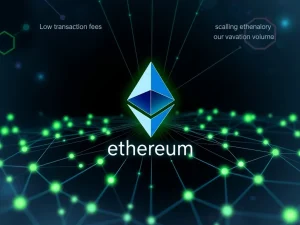Ethereum Interoperability: Unlocking a Seamless Future for Layer 2 UX

The Ethereum ecosystem, a powerhouse of decentralized innovation, faces a critical challenge: fragmentation. As Layer 2 (L2) solutions proliferate, users often encounter complex and disjointed experiences. Recognizing this, the Ethereum Foundation has declared **Ethereum interoperability** its top near-term user experience (UX) priority. This strategic focus aims to unify the diverse L2 landscape, creating a smoother and more intuitive journey for every user.
Ethereum Foundation Drives Interoperability Forward
Ethereum Foundation researchers recently emphasized the paramount importance of interoperability. They stated that this initiative represents the highest leverage opportunity within the UX domain for the next six to twelve months. This focused effort seeks to address the growing pains associated with Ethereum’s expansion. Furthermore, it aims to streamline how users interact with the burgeoning network of Layer 2 protocols.
The core strategy revolves around two key technological advancements: intent-based architecture and general message-passing. In essence, the goal is to empower users to simply express their desired outcomes, or “intents.” The network then handles the underlying, complex transactions automatically. Additionally, upgrading the cross-chain “pipes” — the message-passing infrastructure — is crucial. This ensures these intents execute smoothly and efficiently across various Layer 1 and Layer 2 solutions.
The Urgent Need for Layer 2 Interoperability
While Layer 2 solutions significantly enhance Ethereum’s scalability and functionality, they also introduce challenges. Chief among these is fragmentation. Users often face difficulties moving assets or interacting with applications across different L2s. This creates a disjointed and often frustrating experience. Consequently, it hinders wider adoption.
Consider the typical user journey: transferring tokens from one L2 to another can involve multiple steps, varying bridge designs, and significant wait times. This complexity deters new users and frustrates experienced ones. Therefore, improving **Layer 2 interoperability** is not merely a technical goal; it is a fundamental requirement for a truly user-friendly and accessible decentralized internet. The Ethereum Foundation aims to alleviate these pain points directly.
Revolutionizing UX with Intent-Based Architecture Ethereum
A cornerstone of the Ethereum Foundation’s interoperability strategy is the adoption of **intent-based architecture Ethereum**. This innovative approach shifts the focus from specifying exact transaction details to simply stating the desired end-state. For example, instead of a user manually bridging tokens and then swapping them, they could simply express an intent like, “I want 100 USDC on Arbitrum from my ETH on Optimism.” The network would then orchestrate the necessary low-level transactions autonomously.
This abstraction significantly simplifies the user experience. It reduces the cognitive load and potential for error. The system intelligently finds the most efficient and secure path to fulfill the user’s intent. This represents a paradigm shift in how users interact with decentralized applications, making complex operations feel seamless. The network handles the intricate details, allowing users to focus purely on their goals.
Enhancing Cross-Chain Messaging for Faster Transactions
Effective **cross-chain messaging** is the backbone of any robust interoperability solution. Currently, the speed of message-passing between different chains and rollups can be a significant bottleneck. Slow settlement times impede the smooth execution of cross-chain intents. The Ethereum Foundation recognizes this critical area for improvement.
Researchers are actively working to optimize several key metrics. These include:
- Time-to-inclusion: How quickly a transaction is added to a block.
- Confirmation/Finality: The speed at which a transaction is irreversibly settled.
- Layer-2 settlement: The efficiency of settling transactions on L2s.
- Signatures per operation: Reducing the number of user signatures required for complex actions.
By enhancing these aspects, the Foundation aims to accelerate the entire cross-chain process. This will ensure that user intents are executed swiftly and reliably, regardless of the underlying chains involved. The focus is on creating a truly responsive and unified ecosystem.
Three Strategic Streams for Ethereum Interoperability
The Ethereum Foundation has structured its interoperability work into three distinct, yet interconnected, development streams: Initialization, Acceleration, and Finalization. This methodical approach ensures comprehensive progress across all critical areas.
Stream 1: Initialization and Core Standards
The first stream, Initialization, primarily focuses on developing the foundational elements for intent-based architecture. It encompasses three major projects:
- Open Intents Framework: This is a modular, lightweight stack designed to facilitate the use of intents in Ethereum development. Production smart contracts are already live, with audits anticipated for Q3 this year. Cross-chain validation is expected in Q4, paving the way for widespread adoption.
- Ethereum Interoperability Layer: Led by the **ERC-4337** team, this layer provides a trustless cross-L2 “transport” for prescriptive execution across various Layer 2 protocols. ERC-4337 is Ethereum’s account abstraction standard, significantly improving smart contract wallets by allowing them to initiate transactions directly.
- Interoperability Standards: These standards are crucial for ensuring a consistent and seamless cross-chain user experience. Key developments include:
- ERC-7828/7930: Defines interoperable addresses, making it easier to identify and interact with users across different chains.
- ERC-7811: Standardizes asset consolidation, allowing the same token across various chains and wrappers to be treated as a single balance. This simplifies asset management for users.
- ERC-5792: Formalizes multi-call flows, enabling users to execute multiple actions in a single transaction, enhancing efficiency.
- ERC-7683: Specifies a common intent format, providing a universal language for expressing user desires.
- ERC-7786: Offers a neutral messaging interface, making bridges and verification backends interchangeable. This promotes flexibility and reduces reliance on single solutions.
Stream 2 & 3: Speed and Finishing Touches
The second development stream, Acceleration, focuses intently on increasing transaction speed at every layer of the Ethereum ecosystem. This involves optimizing various components to reduce latency and improve overall throughput. Faster processing times are essential for a truly responsive and efficient user experience, especially in a multi-chain environment.
Finally, the third stream, Finalization, addresses the finishing touches necessary for a robust and secure interoperable system. This stream is currently exploring advanced solutions to improve zero-knowledge proof support. Zero-knowledge proofs are vital for privacy and scalability in decentralized systems. Furthermore, efforts are underway to enhance Layer 1 finality times. Stronger L1 finality provides a more secure anchor for all connected Layer 2 solutions, bolstering the entire network’s integrity.
The Ethereum Foundation’s commitment to **Ethereum interoperability** marks a pivotal moment for the ecosystem. By tackling fragmentation head-on through intent-based architecture, improved **cross-chain messaging**, and unifying standards, they are paving the way for a truly seamless and intuitive user experience. These strategic initiatives promise to unlock the full potential of Layer 2s, ensuring Ethereum remains at the forefront of blockchain innovation and accessibility for all.










